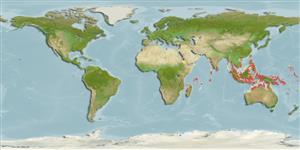>
Siluriformes (Catfishes) >
Ariidae (Sea catfishes) > Ariinae
Etymology: Arius: Greek, arios, areios = dealing with Mars, warlike, bellicose (Ref. 45335).
More on author: Valenciennes.
Environment: milieu / climate zone / depth range / distribution range
Ökologie
seewasser; brackwasser demersal; standorttreu; tiefenbereich 0 - 20 m (Ref. 43081). Tropical
Indo-West Pacific: Pakistan east to Thailand then south to the Philippines and Indonesia.
Size / Gewicht / Alter
Maturity: Lm ? range ? - ? cm
Max length : 39.5 cm NG Männchen/unbestimmt; (Ref. 43081); common length : 12.0 cm TL Männchen/unbestimmt; (Ref. 3290)
Found in marine waters, as well as estuaries and tidal rivers, at times burrowed in the soft mud of the mangroves. Feed mainly on invertebrates. Males incubate the eggs in the buccal cavity (Ref. 43081). The sharp dorsal and pectoral fin spines can inflict painful wounds. Also caught with dipnets and set bagnets. Sold mostly fresh.
Males incubate the eggs in the buccal cavity.
Jayaram, K.C., 1984. Ariidae. In W. Fischer and G. Bianchi (eds.) FAO species identification sheets for fishery purposes. Western Indian Ocean fishing area 51. Vol. 1. FAO, Rome. pag. var. (Ref. 3290)
IUCN Rote Liste Status (Ref. 130435)
Bedrohung für Menschen
Traumatogenic (Ref. 3290)
Nutzung durch Menschen
Fischereien: kommerziell
Mehr Information
ReferenzenAquakulturAquakultur ProfilZuchtlinienGenetikElectrophoresesVererbbarkeitKrankheitenVerarbeitungNutrientsMass conversion
PartnerBilderStamps, Coins Misc.LauteCiguateraGeschwindigkeitSchwimmstilKiemenoberflächeOtolithsGehirngrößeSehfähigkeit
Tools
Zusatzinformationen
Download XML
Internet Quellen
Estimates based on models
Preferred temperature (Ref.
123201): 27.4 - 29.3, mean 28.7 °C (based on 1689 cells).
Phylogenetic diversity index (Ref.
82804): PD
50 = 0.5000 [Uniqueness, from 0.5 = low to 2.0 = high].
Bayesian length-weight: a=0.00776 (0.00492 - 0.01225), b=2.98 (2.85 - 3.11), in cm total length, based on LWR estimates for this species & (Sub)family-body (Ref.
93245).
Trophic level (Ref.
69278): 2.8 ±0.31 se; based on food items.
Widerstandsfähigkeit (Ref.
120179): niedrig, Verdopplung der Population dauert 4,5 - 14 Jahre. (Fec=25-35).
Fishing Vulnerability (Ref.
59153): Moderate vulnerability (35 of 100).
